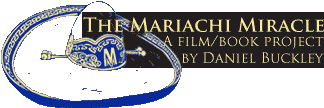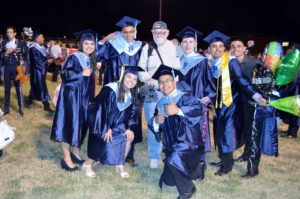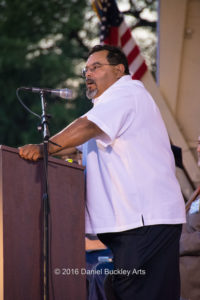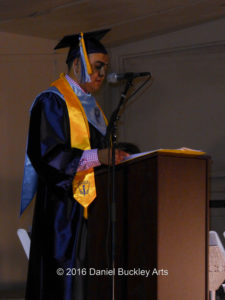Click photos to enlarge
Preparation of my footage and photos from Pueblo High Magnet School’s May 25, 2016 graduation offers a real-world example of why making The Mariachi Miracle is such a costly and time consuming process.
Roughly two and a half hours of footage and 600 still images were shot at the graduation, starting with photos of signage, video and stills of the new recruits to Mariachi Aztlan getting set to play, and then out to the field to capture the event.
Not every part of the whole ceremony was filmed, but key speeches, the national anthem, color guard, the entrance of the seniors, shots of the crowd, and then the final opening of the gates with families rushing the graduates all made their way to video. The camera was set up in such a way as to catch every graduate’s face as they paraded by the bleachers, and some again as they walked in to take their seat. As many as possible of the graduates receiving their diploma were filmed, with special emphasis on the nine seniors leaving Mariachi Aztlan. And of course the flood of emotions as families crowded around and posed with seniors was a key target.
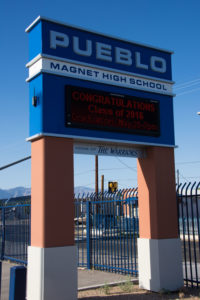 The main still camera crapped out about halfway through the ceremony due to a technical glitch, so the focus shifted to video. In the end it proved a good thing because juggling stills and videos simultaneously always means bad results for each.
The main still camera crapped out about halfway through the ceremony due to a technical glitch, so the focus shifted to video. In the end it proved a good thing because juggling stills and videos simultaneously always means bad results for each.
Once home it took the same amount of time to ingest the footage onto my computer as it did to shoot. Likewise the photos took a large block of time to input, add metadata and catalog. And once in, both had to be backed up on a separate drive.
All of this was begun around 10 p.m. and finally finished just after 5 a.m. the next morning, taking time along the way to edit some key photos to share with families on Facebook.
Friday I returned to look at the footage and begin placing markers and identifying various sections of the 33 clips shot. Those clips ranged from a few seconds to well over an hour. Initially I went through and jotted general notes into the database. And then the focus shifted to the speeches, crowd footage, entry and diploma footage, etc. adding markers within the clips and jotting down what’s located each marker using an iPad.
Over the next week a short video about the Aztlan class of 2016 will be created, using interviews shot earlier in the month with the graduates, along with video and stills from various performances, rehearsals, trips, and graduation. In that context, Principal Augustine Romero’s speech was very important.
From an audio standpoint the speech was problematic. Where the camera had been set up, sound from the stage returned from the bleacher speakers with a bit of reverb-like delay, and there was a considerable ground hum through much of his speech. Using Izotope RX and Ozone audio restoration and mastering software, and a whole lot of experimentation, a much improved audio track was achieved. That speech included some important facts and figures about Pueblo’s graduation rate relative to the national and local averages, as well as scholarship figures and much more. So it was not a minor issue to fix that audio.
Most of the detail work undertaken today involved placing well over 800 markers to identify points of interest that need to be located quickly when the actual editing takes place. And this is one of hundreds of similar batches of clips with numerous markers, their contents carefully noted and entered in databases where they can be pulled up when the time comes. In all it took just shy of 11 hours to put all of the ID tags in place for the graduation shoot.
Another vital step that goes into all of this is the transcription of all of the interviews conducted for the film. It is painstaking, intricate work, done by Shawn Humberson in Wyoming. Before she can go to work on that the audio from every interview clip must be compressed and processed, exported, converted to MP3s and sent via a DropBox-like service. Shawn then meticulously transcribes every word, verbatim, and sends back the results in Microsoft Word documents.
There’s a reason for her precision. It’s easy to paraphrase someone’s quote and discover too late that they took way too long to come to the point. In the final edit one must find THE person who most concisely says what needs to be expressed. Sometimes it takes splicing together part of what one person says with part of another. Other times a voice-over is needed, although they are generally avoided. I prefer to only use the voices of those who experienced what it being spoken of. Still, every second counts in the final edit, and whatever works best wins the day.
The other key information Shawn provides in her transcription work is the time within the clip that each new page begins. This is immensely helpful in locating the quote quickly at editing time.
Once the transcripts arrive they are printed out, read through without marking, then reread, this time using highlighter pens to identify important quotes.A legal pad with a page for each topic helps organize the quotes. Beneath each header is a snippet of who says what, the name of the clip it comes from, and the number of the page in the transcript so that its location in the clip can be determined.
From those topic pages, a flow chart of the verbal story is fashioned and the major bricks of the story line are laid into place. When the person speaking refers to a particular event or action, the markers inserted into the raw footage from various individual shoots (such as this graduation session) help locate a snippet to visually illustrate the event mentioned. Often several clips are brought up, to choose which visual illustration works best.
The five-six minute montage that will be assembled about the class of 2016 will take the better part of seven long days to complete. The film itself will require in the neighborhood of six months to edit. And there are still many months of interviews, events, rehearsals, location shots and more to film to make sure that the raw materials are in place when the time comes to edit the final film.
It’s not magic. It takes hard work and lots of it, a good memory and a knack for breaking the essential story elements out from the chatter. In the end, the story telling is just part of the work and expense. Photos must be tracked down, release forms confirmed, permission obtained and royalties paid to use copyrighted music, and much more. Together this medley of media generates an engaging and powerful story worthy of the subject matter that has taken nearly five years to assemble.
 The Mariachi Miracle is a complex and important story and by far my most ambitious project to date. And while the lion’s share of the project falls in my hands, I always need financial help to keep it going. We’re on a tight schedule between now and mid-October to finish filming, After that, editing, book writing and post production chores will keep me very busy until the end of March. With your help we’ll make the deadline of having both the film and book ready to sneak preview at the Tucson International Mariachi Confernce in April, 2017.
The Mariachi Miracle is a complex and important story and by far my most ambitious project to date. And while the lion’s share of the project falls in my hands, I always need financial help to keep it going. We’re on a tight schedule between now and mid-October to finish filming, After that, editing, book writing and post production chores will keep me very busy until the end of March. With your help we’ll make the deadline of having both the film and book ready to sneak preview at the Tucson International Mariachi Confernce in April, 2017.
